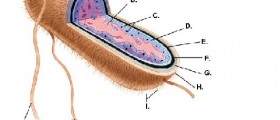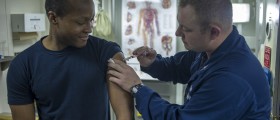
Salmonella infection, also known as Salmonellosis, is an infection by the Salmonella bacteria. The first symptoms of infection occur 8 to 72 hours after the infection and last for 4 to 7 days. The symptoms may vary from one patient to another but in most of the cases, patients don’t require any kind of special treatment. In severe cases, patients may need to be hospitalized and to receive intravenous fluids in order to recover. The most dangerous complications of salmonella infection may occur if the infection spreads from the intestines to the blood stream and infect other organs in the body. This is the case of bacterial sepsis, which is usually fatal. Approximately 142,000 Americans are infected each year with Salmonella from chicken eggs, and about 30 die.
Causes of salmonella infection
Salmonella bacteria lives in the intestines of humans and other animals, and it can be spread trough feces. Eggs are the most common way of spreading salmonella. The shell of the egg may be contaminated with salmonella by feces or environment, or its inside may be contaminated by penetration of the bacteria through the shell or from a hen, whose infected ovaries contaminate the egg during egg formation. The other commonly infected foods are raw meat, poultry, seafood, fruits and vegetables. Feces may contaminate raw meat and poultry during the butchering process, while the contaminated fish may originate from contaminated waters. Fruits and vegetables are becoming contaminated if they are washed or watered with contaminated water.
Another significant source of contamination is when people who do not wash their hands thoroughly after using the toilet prepare the food. Touching the contaminated surfaces or animals, and putting the finger in the mouth, is yet another source of infection, especially dangerous for children.
Symptoms of salmonella infection
In most cases, salmonella infection looks like a simple gastroenteritis, accompanied with severe diarrhea. In these cases patient’s do not need any kind of special treatment. Taking a lot of fluids and eating dry foods will resolve the condition in a couple of days. However, symptoms may sometimes be more severe and include anything from nausea, vomiting, abdominal pain, diarrhea, fever, chills, headache, muscle pains, and blood in the stool.
A rare form of Salmonella, known as typhoidal Salmonella, can cause typhoid fever. This condition is usually caused by direct contact with the fecal matter of the carrier. Symptoms of Typhoid fever include: diarrhea, constipation, fever over 102 F (38.8 C), raised pink spots on the upper chest, cough, mental confusion, slow heartbeat, and enlargement of the liver and spleen. Infections with the typhoidal Salmonella are the most common in undeveloped countries.

















Your thoughts on this
Loading...